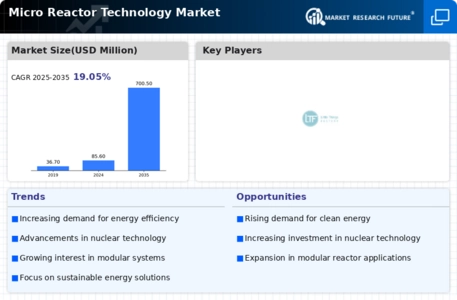-
Report Prologue
-
Market Introduction
-
Definition 11
- Scope Of The Study 11
- Research Objectives 11
- Assumptions 11
- Limitations 12
-
Markets Structure 12
-
Research Methodology
-
Research Process 13
-
Primary Research 14
-
Secondary Research 14
-
Market Size Estimation 15
-
Forecast Model 16
-
Market Dynamics
-
Drivers 17
- Increasing Demand Of 3-D Printed Micro Reactor Owing To Its Relative Affordability And High Designing Capability Is Anticipated To Drive The Market Demand Over The Forecast Period 17
- Growing Nano Pharmaceutics Market Driving MRT Application In Pharmaceuticals Industry 17
- Increasing Regulations And Rising Safety Concerns In Chemical Industry Affecting The Micro Reactor Technology Market In A Constructive Manner 18
-
Restraints 18
- High Cost And High Time To Market Required For MRT Hampering The Market Growth 18
- Limited Manufacturing Capabilities Of MRT Restraining Market Growth In Commodity Chemical End-Use Industry
-
Market Trends 19
- Innovative Materials Being Used In Micro Reactors 19
-
Opportunity 19
- Commodity Chemicals Industry Offers Lucrative Opportunity To The Micro Reactor Technology Market 19
-
Market Factor Analysis
-
Supply Chain Analysis 20
- Raw Material Suppliers 20
- Micro Reactor Technology Producers 21
- Micro Reactor Technology Distributors 21
- Micro Reactor Technology End Users 21
-
Porter's 5 Forces Analysis 22
- Threat Of New Entrants 22
- Bargaining Power Of Supplier 23
- Threat Of Substitute 23
- Bargaining Power Of Buyers 23
- Rivalry 24
-
Global Micro Reactor Technology Market, By Type
-
Introduction 25
-
Disposable 26
-
Reusable 27
-
Global Micro Reactor Technology Market, By Application
-
Introduction 28
-
Chemical Synthesis 29
-
Polymer Synthesis 30
-
Process Analysis 31
-
Material Analysis 32
-
Others 33
-
Global Micro Reactor Technology Market, By End Use
-
Introduction 34
-
Specialty Chemicals 35
-
Pharmaceuticals 36
-
Commodity Chemicals 37
-
Others 39
-
Global Micro Reactor Technology Market, By Region
-
Introduction 40
-
North America 41
- US 42
- Canada 44
-
Europe 46
- Germany 48
- UK 49
- France 51
- Italy 52
- Rest Of Europe 54
-
Asia-Pacific 56
- China 58
- Japan 59
- India 61
- Rest Of Asia-Pacific 62
-
Latin America 64
-
Middle East & Africa 65
-
Competitive Landscape
-
Introduction: Key Players 67
-
Collaboration 68
-
Expansion 69
-
Product Launch 70
-
Major Consumers, By End User 71
-
Key Players
-
AM Technology 73
- Company Overview 73
- Product/Business Segment Overview 74
- Financial Updates 74
-
Little Things Factory 75
- Company Overview 75
- Product/Business Segment Overview 76
- Financial Updates 76
- Key Developments 76
-
Microinnova Engineering GmbH 77
- Company Overview 77
- Product/Business Segment Overview 77
- Financial Updates 77
-
Thaletec GmbH 78
- Company Overview 78
- Product/Business Segment Overview 78
-
Vapourtec Ltd 79
- Company Overview 79
- Product/Business Segment Overview 79
- Financial Updates 80
- Key Developments 80
-
Ehrfeld Mikrotechnik BTS 81
- Company Overview 81
- Product/Business Segment Overview 81
- Financial Updates 82
- Key Developments 82
-
Uniqsis Ltd 83
- Company Profile 83
- Product/Business Segment Overview 83
- Financial Updates 84
- Key Developments 84
-
Chemtrix Ltd 85
- Company Overview 85
- Product/Business Segment Overview 85
- Financial Updates 85
- Key Developments 86
-
Conclusion
-
List Of Tables
-
GLOBAL MICRO REACTOR TECHNOLOGY MARKET, BY TYPE, 2020-2027 (USD MILLION) 25
-
GLOBAL DISPOSABLE MARKET FOR MICRO-REACTOR TECHNOLOGY, BY REGION, 2020-2027 (USD MILLION) 26
-
GLOBAL REUSABLE MARKET FOR MICRO-REACTOR TECHNOLOGY, BY REGION, 2020-2027 (USD MILLION) 27
-
GLOBAL MICRO REACTOR TECHNOLOGY MARKET, BY APPLICATION, 2020-2027 (USD MILLION) 28
-
GLOBAL CHEMICAL SYNTHESIS MARKET FOR MICRO REACTOR TECHNOLOGY, BY APPLICATION, 2020-2027 (USD MILLION) 29
-
GLOBAL POLYMER SYNTHESIS MARKET FOR MICRO REACTOR TECHNOLOGY, BY APPLICATION, 2020-2027 (USD MILLION) 30
-
GLOBAL PROCESS ANALYSIS MARKET FOR MICRO REACTOR TECHNOLOGY, BY APPLICATION, 2020-2027 (USD MILLION) 31
-
GLOBAL MATERIAL ANALYSIS MARKET FOR MICRO REACTOR TECHNOLOGY, BY APPLICATION, 2020-2027 (USD MILLION) 32
-
GLOBAL OTHERS MARKET FOR MICRO REACTOR TECHNOLOGY, BY APPLICATION, 2020-2027 (USD MILLION) 33
-
GLOBAL MICRO REACTOR TECHNOLOGY MARKET, BY END USE, 2020-2027 (USD MILLION) 35
-
GLOBAL SPECIALTY CHEMICALS MARKET FOR MICRO REACTOR TECHNOLOGY, BY END USE, 2020-2027 (USD MILLION) 36
-
GLOBAL PHARMACEUTICALS MARKET FOR MICRO REACTOR TECHNOLOGY, BY END USE, 2020-2027 (USD MILLION) 37
-
GLOBAL COMMODITY CHEMICALS MARKET FOR MICRO REACTOR TECHNOLOGY, BY END USE, 2020-2027 (USD MILLION) 38
-
GLOBAL OTHERS MARKET FOR MICRO REACTOR TECHNOLOGY, BY END USE, 2020-2027 (USD MILLION) 39
-
GLOBAL MICRO REACTOR TECHNOLOGY MARKET, BY REGION, 2020-2027 (USD MILLION) 40
-
NORTH AMERICA MICRO REACTOR TECHNOLOGY MARKET, BY COUNTRY, 2020-2027 (USD MILLION) 41
-
NORTH AMERICA MICRO REACTOR TECHNOLOGY MARKET, BY TYPE 2020-2027 (USD MILLION) 41
-
NORTH AMERICA MICRO REACTOR TECHNOLOGY MARKET, BY APPLICATION, 2020-2027 (USD MILLION) 42
-
NORTH AMERICA MICRO REACTOR TECHNOLOGY MARKET, BY END USE, 2020-2027 (USD MILLION) 42
-
US MICRO REACTOR TECHNOLOGY MARKET, BY TYPE 2020-2027 (USD MILLION) 43
-
US MICRO REACTOR TECHNOLOGY MARKET, BY APPLICATION, 2020-2027 (USD MILLION) 43
-
US MICRO REACTOR TECHNOLOGY MARKET, BY END USE, 2020-2027 (USD MILLION) 44
-
CANADA MICRO REACTOR TECHNOLOGY MARKET, BY TYPE 2020-2027 (USD MILLION) 44
-
CANADA MICRO REACTOR TECHNOLOGY MARKET, BY APPLICATION, 2020-2027 (USD MILLION) 45
-
CANADA MICRO REACTOR TECHNOLOGY MARKET, BY END USE, 2020-2027 (USD MILLION) 45
-
EUROPE MICRO REACTOR TECHNOLOGY MARKET, BY COUNTRY, 2020-2027 (USD MILLION) 46
-
EUROPE MICRO REACTOR TECHNOLOGY MARKET, BY TYPE 2020-2027 (USD MILLION) 46
-
EUROPE MICRO REACTOR TECHNOLOGY MARKET, BY APPLICATION, 2020-2027 (USD MILLION) 47
-
EUROPE MICRO REACTOR TECHNOLOGY MARKET, BY END USE, 2020-2027 (USD MILLION) 47
-
GERMANY MICRO REACTOR TECHNOLOGY MARKET, BY TYPE 2020-2027 (USD MILLION) 48
-
GERMANY MICRO REACTOR TECHNOLOGY MARKET, BY APPLICATION, 2020-2027 (USD MILLION) 48
-
GERMANY MICRO REACTOR TECHNOLOGY MARKET, BY END USE, 2020-2027 (USD MILLION) 49
-
UK MICRO REACTOR TECHNOLOGY MARKET, BY TYPE 2020-2027 (USD MILLION) 49
-
UK MICRO REACTOR TECHNOLOGY MARKET, BY APPLICATION, 2020-2027 (USD MILLION) 50
-
UK MICRO REACTOR TECHNOLOGY MARKET, BY END USE, 2020-2027 (USD MILLION) 50
-
FRANCE MICRO REACTOR TECHNOLOGY MARKET, BY TYPE 2020-2027 (USD MILLION) 51
-
FRANCE MICRO REACTOR TECHNOLOGY MARKET, BY APPLICATION, 2020-2027 (USD MILLION) 51
-
FRANCE MICRO REACTOR TECHNOLOGY MARKET, BY END USE, 2020-2027 (USD MILLION) 52
-
ITALY MICRO REACTOR TECHNOLOGY MARKET, BY TYPE 2020-2027 (USD MILLION) 52
-
ITALY MICRO REACTOR TECHNOLOGY MARKET, BY APPLICATION, 2020-2027 (USD MILLION) 53
-
ITALY MICRO REACTOR TECHNOLOGY MARKET, BY END USE, 2020-2027 (USD MILLION) 53
-
REST OF EUROPE MICRO REACTOR TECHNOLOGY MARKET, BY TYPE 2020-2027 (USD MILLION) 54
-
REST OF EUROPE MICRO REACTOR TECHNOLOGY MARKET, BY APPLICATION, 2020-2027 (USD MILLION) 54
-
REST OF EUROPE MICRO REACTOR TECHNOLOGY MARKET, BY END USE, 2020-2027 (USD MILLION) 55
-
ASIA-PACIFIC MICRO REACTOR TECHNOLOGY MARKET, BY COUNTRY, 2020-2027 (USD MILLION) 56
-
ASIA-PACIFIC MICRO REACTOR TECHNOLOGY MARKET, BY TYPE 2020-2027 (USD MILLION) 56
-
ASIA-PACIFIC MICRO REACTOR TECHNOLOGY MARKET, BY APPLICATION, 2020-2027 (USD MILLION) 57
-
ASIA-PACIFIC MICRO REACTOR TECHNOLOGY MARKET, BY END USE, 2020-2027 (USD MILLION) 57
-
CHINA MICRO REACTOR TECHNOLOGY MARKET, BY TYPE 2020-2027 (USD MILLION) 58
-
CHINA MICRO REACTOR TECHNOLOGY MARKET, BY APPLICATION, 2020-2027 (USD MILLION) 58
-
CHINA MICRO REACTOR TECHNOLOGY MARKET, BY END USE, 2020-2027 (USD MILLION) 59
-
JAPAN MICRO REACTOR TECHNOLOGY MARKET, BY TYPE 2020-2027 (USD MILLION) 59
-
JAPAN MICRO REACTOR TECHNOLOGY MARKET, BY APPLICATION, 2020-2027 (USD MILLION) 60
-
JAPAN MICRO REACTOR TECHNOLOGY MARKET, BY END USE, 2020-2027 (USD MILLION) 60
-
INDIA MICRO REACTOR TECHNOLOGY MARKET, BY TYPE 2020-2027 (USD MILLION) 61
-
INDIA MICRO REACTOR TECHNOLOGY MARKET, BY APPLICATION, 2020-2027 (USD MILLION) 61
-
INDIA MICRO REACTOR TECHNOLOGY MARKET, BY END USE, 2020-2027 (USD MILLION) 62
-
REST OF ASIA-PACIFIC MICRO REACTOR TECHNOLOGY MARKET, BY TYPE 2020-2027 (USD MILLION) 62
-
REST OF ASIA-PACIFIC MICRO REACTOR TECHNOLOGY MARKET, BY APPLICATION, 2020-2027 (USD MILLION) 63
-
REST OF ASIA-PACIFIC MICRO REACTOR TECHNOLOGY MARKET, BY END USE, 2020-2027 (USD MILLION) 63
-
LATIN AMERICA MICRO REACTOR TECHNOLOGY MARKET, BY TYPE 2020-2027 (USD MILLION) 64
-
LATIN AMERICA MICRO REACTOR TECHNOLOGY MARKET, BY APPLICATION, 2020-2027 (USD MILLION) 64
-
LATIN AMERICA MICRO REACTOR TECHNOLOGY MARKET, BY END USE, 2020-2027 (USD MILLION) 65
-
MIDDLE EAST & AFRICA MICRO REACTOR TECHNOLOGY MARKET, BY TYPE 2020-2027 (USD MILLION) 65
-
MIDDLE EAST & AFRICA MICRO REACTOR TECHNOLOGY MARKET, BY APPLICATION, 2020-2027 (USD MILLION) 66
-
MIDDLE EAST & AFRICA MICRO REACTOR TECHNOLOGY MARKET, BY END USE, 2020-2027 (USD MILLION) 66
-
COLLABORATION: 2012,2017 68
-
EXPANSION: 2012,2017 69
-
PRODUCT LAUNCH, 2020 70
-
LIST OF MAJOR CONSUMERS - PHARMACEUTICALS 71
-
LIST OF MAJOR CONSUMERS – SPECILATY CHEMICALS 72
-
List Of Figures
-
GLOBAL MICRO REACTOR TECHNOLOGY MARKET OUTLOOK (2020-2027) 10
-
MRFR RESEARCH PROCESS 13
-
TOP DOWN & BOTTOM DOWN APPROACH 15
-
SUPPLY CHAIN ANALYSIS OF GLOBAL MICRO REACTOR TECHNOLOGY MARKET 20
-
PORTER’S 5 FORCES ANALYSIS OF GLOBAL MICRO REACTOR TECHNOLOGY MARKET 22
-
GLOBAL MICRO REACTOR TECHNOLOGY MARKET, BY TYPE, 2020-2027 (USD MILLION) 25
-
GLOBAL MICRO REACTOR TECHNOLOGY MARKET, BY APPLICATION, 2020-2027 (USD MILLION) 28
-
GLOBAL MICRO REACTOR TECHNOLOGY MARKET, BY END USE, 2020-2027 (USD MILLION) 34
-
GLOBAL MARKET SHARE FOR MICRO REACTOR TECHNOLOGY MARKET, BY REGION IN 2015 40
-
COLLABORATION WAS THE KEY GROWTH STARTERGY ADOPTED BY MICRO REACTORS TECHNOLOGY PLAYERS, 2020 67
-
COLLABORATION: THE MAJOR STRATERGY ADOPTED BY, CHEMTRIX LTD, 2020 68
-
GLOBAL MICRO REACTOR TECHNOLOGY MARKET SHARE, BY REGION (2016-2022) 88

















Leave a Comment